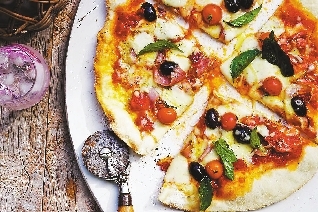
A DELICIOUSLY fresh pizza pie with warm baked dough, salty tomato sauce and gooey cheese is a delight for the senses. In a recent study, pizza was ranked as the food most associated with symptoms of addiction, according to the Yale Food Addiction Scale, a tool that assesses the diagnostic criteria for substance-use disorders in reference to highly processed foods. But what is it specifically about pizza that makes it so universally craved? The psychological response to pizza’s ingredient combinations is partially explained by the fact that highly processed foods like pizza, with added amounts of fat, refined carbohydrates and salt, are most associated with behavioral indicators of addiction, such as loss of control over consumption, cravings and continued consumption despite negative consequences, according to Erica M. Schulte, a doctoral candidate in clinical psychology at the University of Michigan who authored the recent study. “Pizza is the Holy Trinity of crust, cheese and sauce that really accentuates that whole umami thing,” said Bill DeJournett, managing editor of PMQ Pizza Magazine. “Cheese is addictive on its own … and what is better than bread and cheese? And then when you pair with sauce, it takes it to a whole new level, and it’s irresistible.” The type of crust or sauce you prefer for your pizza can be very personal. “The thinner crust gives you a bit more crispness … but some people like having a more bready, chewy pizza to process,” said Gail Vance Civille, founder and president of Sensory Spectrum, a consulting firm that helps companies, including pizza companies, learn how sensory cues drive consumer perceptions of products. A richer, more flavorful buffalo mozzarella is a variant as well, as is ricotta cheese. Toppings can provide texture or flavor contrasts and add to the sensory experience of eating pizza, experts say. “When you add pepperoni or sausage, you are adding a meaty, chewy texture variety, whereas with vegetables, you are adding tremendous amounts of texture contrast to the whole mix,” Civille said. The combination of pizza’s ingredients “seems to be especially rewarding and does not occur together in foods found in nature … and this may contribute to its association with addictive-like eating behaviors,” Schulte explained. In fact, another recent study found that the combination of fat and carbohydrates seems to elevate the reward potential of highly processed foods more than either alone. “There is likely something inherently more rewarding in the combinations of those ingredients that can trigger an addictive process in some individuals,” Schulte said. Perhaps it’s a survival mechanism. “If you were really starving, pizza is a type of food that would be totally satiating. The fat gives you satiety, the sugar in the bread and the sauce is satisfying, and the salt is going to keep you alive,” Civille said. All of this texture and flavor talk aside, some say the joy and lure of pizza has as much to do with what the experience of eating it represents as its sensory attributes. “It comes down to the feelings you experience when eating pizza with friends or family,” DeJournett said. (SD-Agencies) | 
